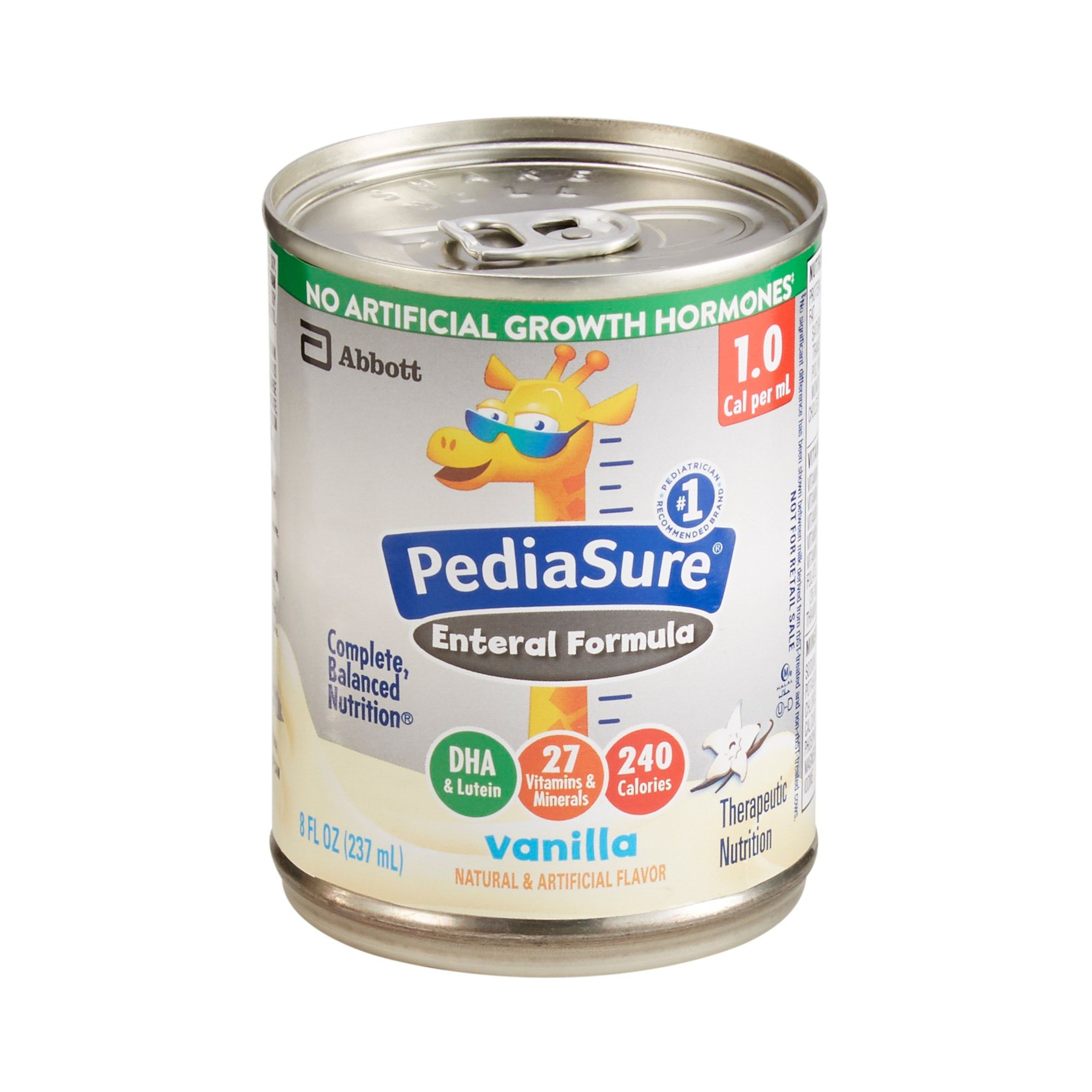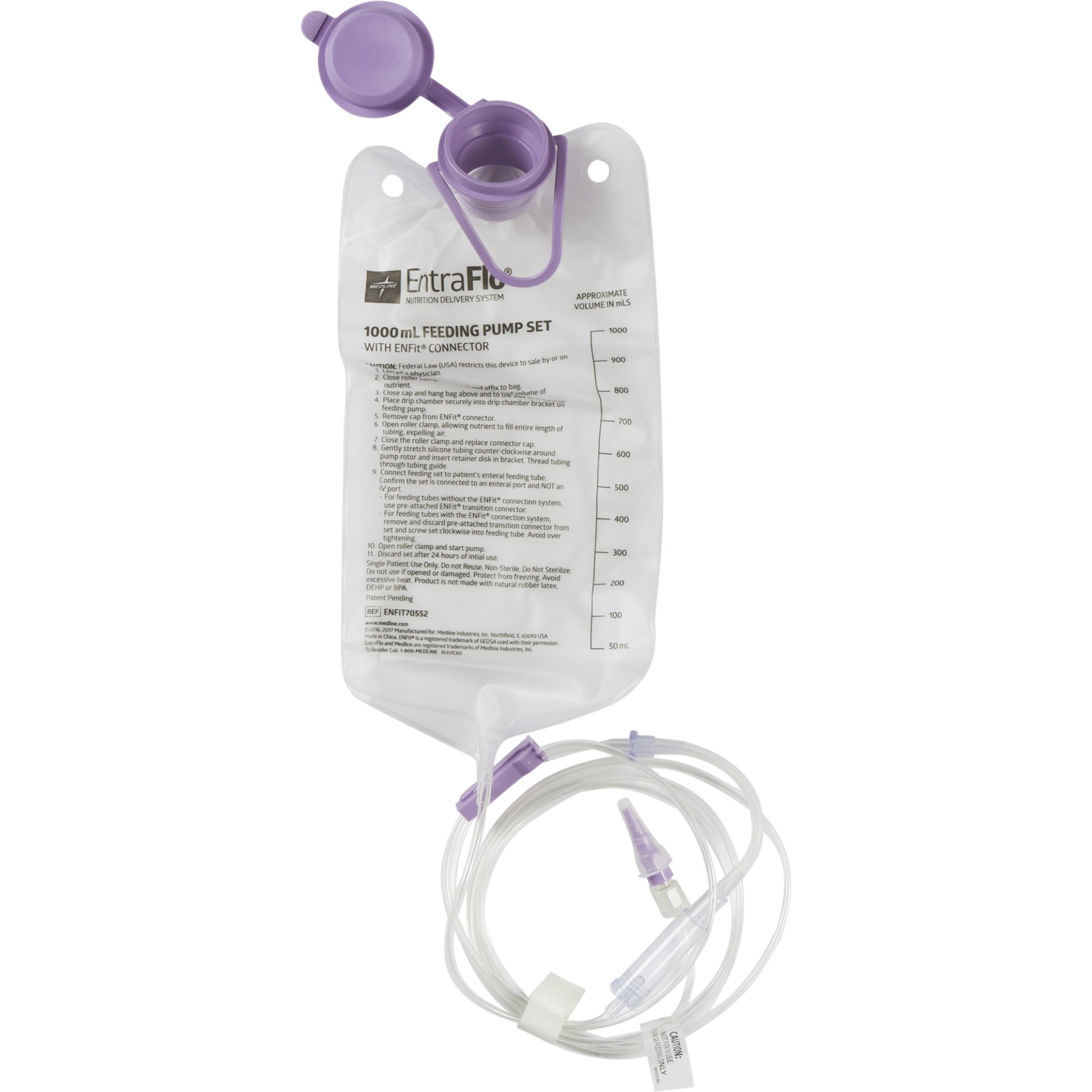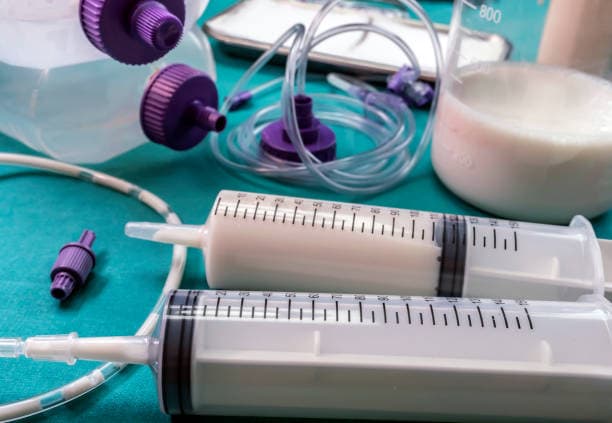If you care for a loved one who experiences difficulty chewing and swallowing, you’ve likely considered enteral nutrition. This approach ensures your child or senior gets the calories and nutrition needed to thrive while reducing the risk of side effects like choking and aspiration.
So, what is enteral feeding? To learn more, we connected with two experts: Keisha Baldeosingh, MD, a board-certified gastroenterologist, and Harsh Sheth, MD, a bariatric and GI laparoscopic surgeon. Here, we explain enteral feeding in depth, answer commonly asked questions, and recommend products to make your life easier.
What Is Enteral Feeding?
“Enteral feeding means getting nutrients, including calories, electrolytes, vitamins, minerals, and fluids, through your intestines,” explains Dr. Baldeosingh. “Imaging skipping the mouth and delivering food directly to the stomach or small intestine with a thin tube,” adds Dr. Sheth. “That’s enteral feeding! It bypasses the chewing and swallowing steps, ensuring essential nutrients reach the body, even when eating isn’t possible.”
For folks who have difficulty chewing and swallowing, enteral feeding provides peace of mind. It helps your loved one stay full and content, no matter their physical abilities.
Are There Different Types of Enteral Feeding?
Dr. Baldeosingh and Dr. Sheth say there are various ways nutrition can be given enterally. Some of the most common options include:
Nasogastric tube (NG tube)
“This type of feeding tube enters through the nose to the stomach,” Dr. Sheth says. “It’s good for short-term or temporary feeding.” For example, Dr. Baldeosingh says NG tubs are often given to “patients who are acutely ill in the ICU and need a quick route for nutrition.”
Nasoduodenal tube (ND tube)
An ND tube is similar to an NG tube. The difference is that the feeding tube extends to the small intestine rather than the stomach. This type of enteral feeding is ideal for longer-term needs, according to Dr. Sheth.
Percutaneous endoscopic gastrostomy tube (PEG tube)
PEG tubes are often recommended to folks “who have neurological illnesses, such as stroke victims,” Dr. Baldeosingh says. “Or, to people who aren’t able to swallow due to weak muscles.”
A PEG tube is placed directly into the stomach. “This can be done endoscopically by a gastroenterologist, radiographically by an interventional radiologist, or surgically with a surgeon, depending on your loved one’s situation,” she adds.
Similar to ND tubes, PEG tubes are used for long-term feeding needs.
Jejunostomy tube (Postpyloric feeding)
A jejunostomy tube is inserted directly into the jejunum, or small intestine during surgery.
“Sometimes there are situations when the stomach is blocked by a tumor or the patient’s stomach doesn’t work (gastroparesis),” Dr. Baldeosingh says. “In these instances, for the patient to get adequate nutrition, the feed must start beyond the stomach.” Sometimes, doctors call this postpyloric feeding.
When Is Enteral Feeding Recommended?
Your loved one might be a candidate for enteral feeding if they have a health problem that keeps them from eating enough calories to meet their basic nutritional needs. If they can’t eat enough to maintain weight or good nutrition, they can develop more serious issues, like malnourishment.
Medical conditions that may benefit from enteral feeding include:
Stroke
Cancer
Dysphagia (difficulty swallowing)
Failure to thrive (a condition that affects infants and children)
Gastrointestinal dysfunction or disease
Neurological disorders, like Alzheimer’s disease, that make eating difficult
Movement disorders, like Parkinson’s disease
Sometimes, enteral feeding is prescribed to patients recovering from severe illnesses or injuries that make them too weak to eat on their own.
Necessary Supplies for Enteral Feeding
The supplies needed for enteral feeding depend on the type of feeding tube your loved one has and their underlying medical condition(s). Even so, Dr. Sheth recommends buying the following:
1) Feeding Pump
A feeding pump is a portable electronic device that pushes formula through a feeding tube and into your loved one’s digestive system. It administers liquid nutrition at a set rate to promote healthy digestion and reduce the risk of side effects, like gas and bloating. Pump feeding is convenient and doesn’t make a mess like syringe feeding.
2) Syringes
Syringes might come in handy if your loved one can administer liquid nutrition on their own. Also known as bolus feeding, syringe feeding, is relatively quick and convenient. It also allows for mobility, since the user isn’t tied to their feeding bag.
One thing to be aware of: Syringe feeding increases the risk of gastrointestinal discomfort. Since you administer this type of nutrition by hand, it's easier to trap air bubbles inside the feeding tube.
Shop Feeding Syringes
3) Formula
Enteral feeding administers nutrition with a liquid formula. Some family caregivers choose to make their tube-feeding formulas at home, but this can be energy-intensive and time-consuming. Similarly, homemade blends may not contain the necessary vitamins, minerals, and nutrients your loved one needs for good nutrition. Therefore, talking with your loved one’s doctor is crucial.
Manufacturers like Nestle, Kate Farms, and RealFood, sell pre-mixed tube feeding formula in cartons and bottles, which can save you time and provide peace of mind.
Shop Enteral Feeding Formula
4) Feeding Bags
Feeding bags are reusable, plastic containers that store enteral feeding formula. Before administering liquid nutrition, simply fill the bag with the formula of your choice and connect it to your loved one’s GI tube. This process takes practice at first. A doctor or registered dietitian can provide step-by-step instructions, so you can avoid common mistakes and confidently feed your loved one.
Shop Feeding Bags
5) Feeding Tubes
Most feeding bags include plastic tubing that can be used to extend your loved one’s GI tube. But it doesn’t hurt to have more in storage. A few extra feet of plastic tubing can extend your loved one’s range of motion and make it easier to feed them or administer liquid medication discreetly.
Shop Feeding Tubes and Feeding Tube Extensions
6) Supplies for Cleaning and Maintenance
Keeping enteral feeding supplies clean is crucial for your loved one’s health and well-being. Most supplies, like feeding bags and syringes, can be hand washed with soap and water or placed in the top rack of the dishwasher. However, you may need additional supplies to manage the health of the skin around your loved one’s feeding tube. We recommend the following supplies:
Tips for Family Caregivers Who Are New to Enteral Feeding
Learning how to safely administer enteral feeding takes time and effort, but Dr. Sheth says there are some “best practices” to follow. These include:
Safety first: “Learn proper tube placement, handling, cleaning, and formula preparation techniques.”
Listen to your loved one: “Observe for signs of discomfort and adjust the feeding position if needed.”
Record, record, record: “Track feeding amounts, and any issues, and communicate them with your healthcare team regularly.”
Resources are your friends: “Seek support from therapists, dietitians, and/or online communities for caregivers.”
Have Enteral Feeding Questions? We’re Here to Support You!
Enteral feeding presents various challenges, but with practice, it gets much easier. If you have questions about administering liquid nutrition or need help finding the right supplies, we’re here to support you. Our friendly Care Team regularly gets questions about enteral feeding and can provide insights to make your job easier. Call (800) 696-CARE or send an email to support@carewell.com.
Get Fast, Free Enteral Feeding Supply Shipping with Autoship
Caring for a child or loved one with a feeding tube requires you to keep various supplies, like feeding bags and formula in storage. We understand, which is why we offer fast, free shipping on orders $49+. Signing up for Autoship ensures you always have enteral feeding supplies on hand, no matter what happens. Some items even qualify for an additional 5% off.
What Is Enteral Feeding - Commonly Asked Questions
1) What happens if you tube feed too fast?
Dr. Sheth says the ideal rate to administer enteral feeding depends on individual factors, but most meals typically take 30-60 minutes. “Feeding too quickly can cause discomfort, like gas, bloating, and diarrhea,” he says. “Your doctor or dietitian will advise on the optimal speed and duration, based on your loved one’s needs.”
Dr. Baldeosingh agrees, adding that “A rate of 10 to 30mL/hour (for standard enteral formulations)” is typically recommended. Over time, you can “slowly increase the target rate” as recommended by your loved one’s doctor or dietitian.
2) What is the difference between enteral and parenteral feeding?
Enteral feeding refers to administering nutrition directly into the stomach or small intestine, bypassing the mouth altogether. Parenteral feeding, on the other hand, “occurs when nutrition, including calories, amino acids, electrolytes, vitamins, minerals, and fluids, is given via an intravenous (IV) route,” explains Dr. Beldeosingh. In other words, parenteral nutrition is administered directly into a vein.
3) Does enteral feeding present any risks?
“Like any medical procedure, enteral feeding can have side effects like nausea, vomiting, and diarrhea,” Dr. Sheth says. “Other potential risks include tube blockage, infection, and electrolyte imbalances. Watch for and report any concerns to your loved one’s doctor promptly.”











